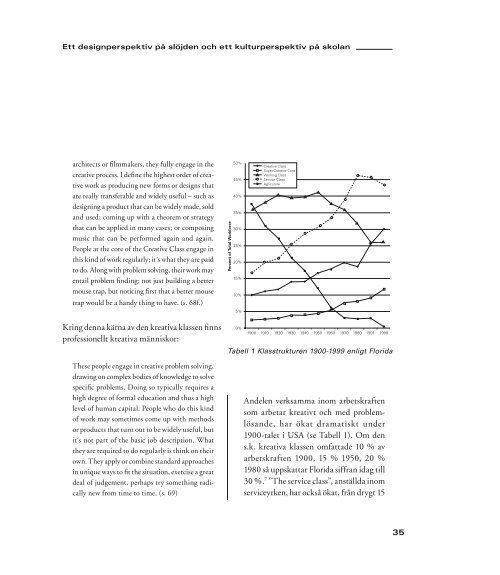idskrift - Umeå universitet
idskrift - Umeå universitet
idskrift - Umeå universitet
You also want an ePaper? Increase the reach of your titles
YUMPU automatically turns print PDFs into web optimized ePapers that Google loves.
Ett designperspektiv på slöjden och ett kulturperspektiv på skolan<br />
architects or filmmakers, they fully engage in the<br />
creative process. I define the highest order of creative<br />
work as producing new forms or designs that<br />
are really transferable and widely useful – such as<br />
designing a product that can be widely made, sold<br />
and used; coming up with a theorem or strategy<br />
that can be applied in many cases; or composing<br />
music that can be performed again and again.<br />
People at the core of the Creative Class engage in<br />
this kind of work regularly; it´s what they are paid<br />
to do. Along with problem solving, their work may<br />
entail problem finding; not just building a better<br />
mouse trap, but noticing first that a better mouse<br />
trap would be a handy thing to have. (s. 68f.)<br />
Percent of Total Workforce<br />
50%<br />
45%<br />
40%<br />
35%<br />
30%<br />
25%<br />
20%<br />
15%<br />
10%<br />
5%<br />
Creative Class<br />
Super-Creative Core<br />
Working Class<br />
Service Class<br />
Agricuture<br />
Kring denna kärna av den kreativa klassen finns<br />
professionellt kreativa människor:<br />
These people engage in creative problem solving,<br />
drawing on complex bodies of knowledge to solve<br />
specific problems. Doing so typically requires a<br />
high degree of formal education and thus a high<br />
level of human capital. People who do this kind<br />
of work may sometimes come up with methods<br />
or products that turn out to be widely useful, but<br />
it´s not part of the basic job description. What<br />
they are required to do regularly is think on their<br />
own. They apply or combine standard approaches<br />
in unique ways to fit the situation, exercise a great<br />
deal of judgement, perhaps try something radically<br />
new from time to time. (s. 69)<br />
0%<br />
1900 1910 1920 1930 1940 1950 1960 1970 1980 1991 1999<br />
FIGURE 4.2 The Class Structure, 1900–1999 (Percent of Work Force)<br />
Tabell 1 Klasstrukturen 1900-1999 enligt Florida<br />
Andelen verksamma inom arbetskraften<br />
som arbetar kreativt och med problemlösande,<br />
har ökat dramatiskt under<br />
1900-talet i USA (se Tabell 1). Om den<br />
s.k. kreativa klassen omfattade 10 % av<br />
arbetskraften 1900, 15 % 1950, 20 %<br />
1980 så uppskattar Florida siffran idag till<br />
30 %. 7 ”The service class”, anställda inom<br />
serviceyrken, har också ökat, från drygt 15<br />
35

















